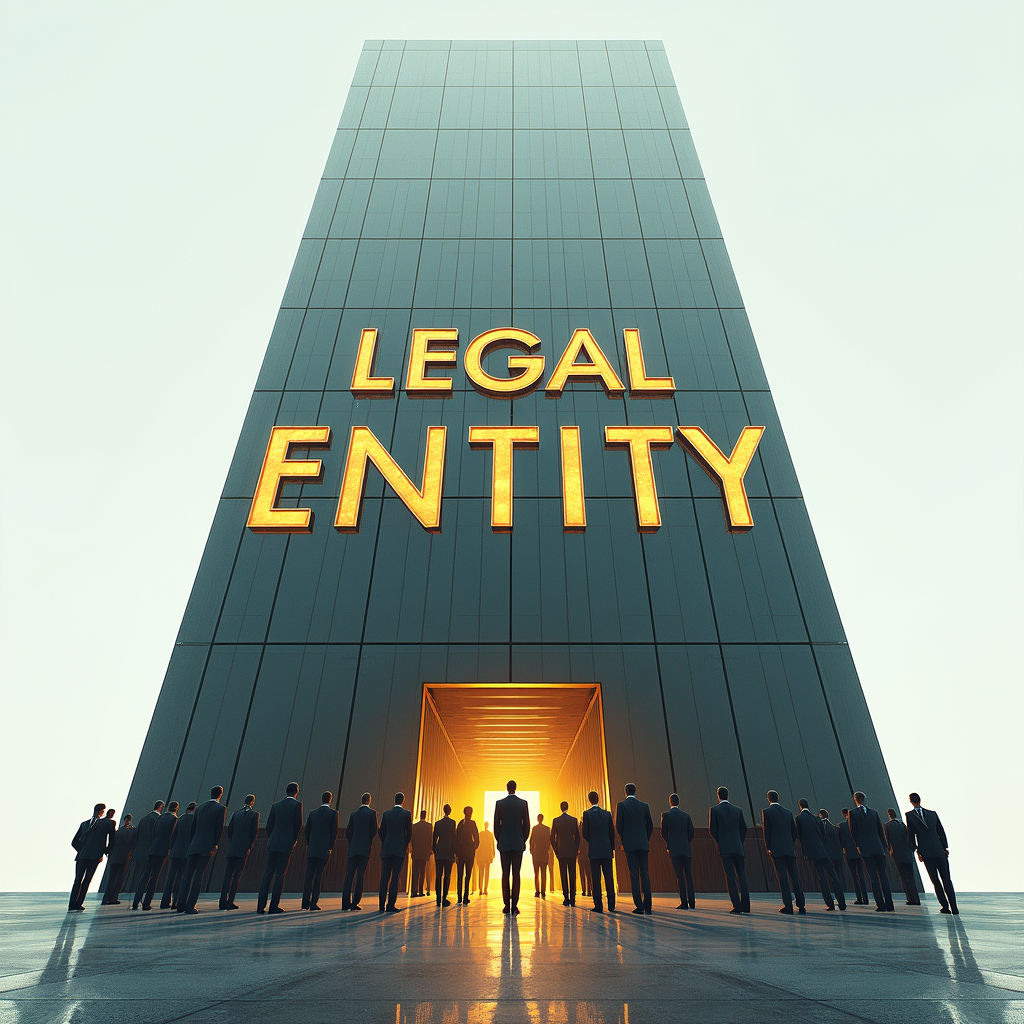This article is written by Tejaswini Kaushal and further updated by Ashwani Dwivedi. The article discusses the ‘concept of separate legal entity’. It talks about the history, implications, and cases that led to the development of the concept.
Table of Contents
Introduction
The legal personality of a company or its legal existence as a separate legal entity has been recognised since medieval times, and several judgements have been pronounced by various courts since the 17th century, acknowledging the notion of a corporation’s independent legal being.
The concept of a separate legal entity as it pertained to huge joint stock firms emerged throughout much of the nineteenth century, particularly between 1840 and 1880. This transformation was slow and entailed minor modifications on several fronts. The change in nature of shareholding and the refining of internal relationships inside a company were some of the legal innovations and improvements done under common law. These helped in distinguishing a company from its shareholders, and hence in distinguishing companies from partnerships.
Companies modified their capital structures and methods of raising capital to make themselves more appealing to investors at the same time. These methods also reflected the investing sector’s differentiation between joint stock companies and partnerships. Thus, it has grown significantly through judicial precedents and legislative interventions, making it an important concept with legal implications for businesses.
To truly understand why companies enjoy a distinct legal personality, we must delve into the concept of a ‘separate legal entity.
What is a separate legal entity
A separate legal entity is a ‘legal person’ i.e., a person recognised by law. Separate from persons who govern and/or own the company, the entity has its own legal rights and duties.
A separate legal entity has the following essential characteristics:
- It can buy, sell, and own any type of property under its own name,
- It can enter into contracts and
- Sue in its own name and be sued in its own name.
As a result of these characteristics, independent legal entities can:
- Owe money (which is created by a contractual relationship) by lending to others, they become creditors
- Own assets, including
i. Tangible assets: Land, buildings, furniture, etc.
ii. Intangible assets: Intellectual property rights: designs, trademarks, trade secrets, etc.
- Be responsible for paying taxes (a statutory obligation).
From a legal standpoint, all legal entities that can accomplish what a human can are classified as separate legal entities.
For instance, a company is a group of two or more people who work together to achieve a similar commercial goal. It is a ‘separate legal entity’ with a unique identity among its members. A company can possess property in its own name, sue and be sued in its own name, and enjoy everlasting succession as a legal entity, among other things.
However, because a company is an artificial person, it can only act via its agents, which are the Board of Directors. Also, they are responsible personally until the company is incorporated.
‘Incorporation of a company’ is the legal process of establishing a corporate company as a separate legal entity from its members. To start a company, a group of people must get a certificate of incorporation from the Registrar of Companies (ROC).
The Companies Act, 2013, which was adopted for the first time in 1913, governs companies in India. It has undergone amendments in 2015, 2017, 2019, and most recently in 2020.
Before diving into the concept of a separate legal entity, it’s essential to first understand what a ‘separate entity’ actually means.
What is a separate entity
“Separate legal entity” means a business or group that is legally separate from its proprietors or members. To put it differently, the entity has its own legal rights and responsibilities that are different from those of its owners, directors, or shareholders. It can own goods, sign contracts, get into debt, sue, and be sued in its own name.
A company is a legally distinct entity. The company registers with the state and uses transactions and ownership documentation to keep its operations distinct. Small companies, professional companies, and personal service companies are all different sorts of companies. To operate a business, all forms of businesses except sole proprietorships must register with the state. However, it is important to note that registration with the state does not imply that the company is a separate legal entity.
For instance, a Limited Liability Company (LLC) is likewise distinct since the LLC owners (called members) are only liable for their contributions to the firm.

Similarly, depending on the sort of partnership chosen, partnerships can be independent legal entities with limited responsibility. In a general partnership, each member is individually accountable for the partnership’s obligations and litigation. On the other hand, certain forms of partnerships, however, are classified as limited liability and independent companies.
Additionally, a limited partnership, or Limited Liability Partnership (LLP), can be formed as a distinct entity. A Professional Limited Liability Partnership is a distinct organisation created by a group of professionals (attorneys, CPAs, or architects, for example).
In contrast, a sole proprietorship is not a distinct legal entity. The sole proprietorship business is run by one individual, who is also the owner of the firm. Thus, corporate and individual debts and legal responsibilities are intertwined.
Ultimately, any sort of business can be legally established, but the fundamental reason for doing so is to segregate the firm’s obligations from the liabilities of the person who owns the business.
A company or a person can be held liable for debts as well as litigation arising from carelessness or criminal behaviour. Understanding how the law treats these liabilities helps us see why the concept of a ‘legal entity’ is so important.
What is a legal entity
A legal entity is a person or a group of people who have legal rights and responsibilities concerning contracts, agreements, transactions, payments, obligations, lawsuits, and penalties. It refers to any type of organisation that is legally established in accordance with the country’s laws.
An individual, an organisation, a business, a partnership, or any other social form permitted by the legal framework might be considered a legal entity. It is a body established at the time of legal incorporation with a distinct name and identity in the eyes of the legal system, as opposed to a natural person. There are several forms of legal entities, each with its own set of legal privileges and duties.
A sole proprietor, for example, is a type of legal structure that has the benefit of being low-cost and straightforward but provides no asset protection for the individual. This indicates that the sole proprietor becomes personally liable in such cases. Shareholders in companies, on the other hand, have minimal obligations and liability risk.
Divisions of legal entity
A ‘division’ of a company, generally coined with a distinct name, is used to refer to a business unit inside that certain company, which is a legal entity having a name different from that of the division. Therefore, the division corresponds to that legal entity’s name and does not create a new legal entity.
Sometimes the term ‘division’ refers to one or more legal entities as well. But is an exceptional scenario and has to be confirmed from legal documents and registrations of the company or the division in question. One can do so by conducting company searches to learn the genuine name of the company that is trading and claiming to be a ‘division.’
Branches of legal entity
Any business that wants to expand and relocate will need to find a new location. That’s why several companies have many branches or offices, each with its own physical address. In most cases, nothing is stopping a company from forming a subsidiary of the main company for each branch, with each branch owned by a single subsidiary. But this raises the question of how the new branch location may be lawfully integrated into the company’s structure.
This can be accomplished in one of three ways:
- Establishing a subsidiary with its own legal identity, i.e., a subsidiary which has a separate existence from the main organisation
- Establishing a dependent branch (operating facility), i.e., dependent on the headquarters in every manner and is not a separate legal entity.
- Establishing a separate branch (branch establishment), i.e not a separate legal entity from the main organisation, and acts as a legal and organisational component of the main organisation.
Types of legal entities
Following are the types of legal entities:
Limited liability company
A private limited company is one that has no public shareholders. A private limited company can be founded with as few as 2 members and as many as 200. This kind of company cannot offer the prospectus in the market i..e., cannot take public funding. A private company’s shares are not readily transferable, for example, Google LLC. According to the Companies Act of 2013, a private limited company in India can be one of the following types:

- Company limited by shares
- Company limited by guarantee
- Unlimited company
Public company
A public limited company is one whose shares are publicly traded on a stock market. A public limited company can be established with as few as 7 members. The interchangeability of shares is completely unrestricted. The government, as well as other agencies such as the Reserve Bank of India (RBI), the Securities and Exchange Board of India (SEBI), and others, need greater public disclosures and compliances from a public limited company, for example, Indian Oil Corporation Ltd.
Sole proprietorship
This is the most basic type of company that one may run. A sole proprietorship is not a legally recognised business entity. The owner of the firm is personally accountable for the company’s debts. For tax and legal purposes, the owner and the business are considered one entity, and the business is not taxed separately. Freelancers, for example, often operate as sole proprietors.
One person company (OPC)
The Companies Act of 2013 created the notion of a one person company, allowing a sole proprietorship to enter the corporate framework. This permits a single investor to incorporate a limited liability company. The form of a one-person company is identical to that of a proprietorship, but without the problems that owners typically confront. One of the most essential characteristics of a one person company is that the dangers are restricted to the value of the shares held by that person.
Partnership
Section 4 of the Indian Partnership Act of 1932 defines partnership as a “relationship between individuals who have consented to share the profits of a business carried on by all or any of them acting for all”. A partnership is an agreement between two or more people to split the earnings of a business they manage jointly.
This business may be conducted by all of them or by any of them acting on behalf of all. Individually, the owners of a partnership business are known as ‘partners,’ and together, they are known as ‘firm’ or ‘partnership firm’. ‘Firm Name’ is the name under which the business is conducted. In some ways, the firm is just an acronym for the partners, for example, Red Bull.
A partnership, unlike a company, is not a separate legal entity from its members. It is unable to possess property, incur debts, or file lawsuits in its own name. Furthermore, the partners of a partnership firm are jointly and severally accountable for the firm’s liabilities.
Limited liability partnership (LLP)
The Limited Liability Partnership Act of 2008 controls limited liability partnership concepts in India. It has characteristics of both LLP and a public company. Unlike a partnership, an LLP’s liability is restricted, and neither partner may be held accountable for the actions of the other. It is a separate legal entity having its own distinct entity independent from its members. The fundamental drawback of an LLP is that, unlike a company, it cannot raise cash from the public through an IPO, for example, law firms.
Creating a corporate legal entity entails more than just a name and a mission; it is a systematic procedure for defining the company’s legal identity, rights, and duties. From registration to compliance, we’ll look at how a business comes to life in the eyes of the law.
Means of formulating a corporate legal entity
A corporation’s legal personality can be formed in one of four ways:
Maintaining consistency
This means that a company can continue to do business, own property, and carry out contracts without interruption. The legal organisation can continue to exist over time even if the owner dies or withdraws the corporation’s assets. The life of a corporation is immortal, which means that the company continues to operate without interruption until it is wound up by a procedure. This principle was established in the landmark judgement of Trustees of Dartmouth College v. Woodward, (1819).
Creating an ‘identifiable persona’
The name by which the corporation is known is referred to as an ‘identifiable persona.’ The name of the corporation acts as a legally liable person who is liable for its actions and omissions during the carrying out of business activities. The names of the people involved in that corporation are well-known. The title or name of the company are the corporation’s intangible assets, such as a franchise, exclusive rights, reputation, image brand, and so on. Intangible assets are a lucrative source of revenue for businesses. This persona is utilised in all contracts, and in this persona, a corporation can sue and be sued.

Assets specification
There should be a mechanism in place to segregate the assets of the corporation from the assets of the shareholders, as well as a specification of which assets are allocated to the business. This asset separation makes it effortless for those who plan to invest or contribute to the business. It also ensures that, in the event of the corporation’s dissolution, a person will have to bear a defined amount of loss (principle of limited liability).
Self-governance
A corporation must have a system and capacity to control its internal affairs in order to be considered a legal entity. The corporation should have the authority to make internal governance decisions.
Before understanding the significance of a separate legal entity, it’s essential to look back at the origins of this concept and understand its historical roots.
Origin of separate legal entity
The evolution of corporate personhood has a long history, and research suggests that this concept was first created for religious and church purposes in the middle ages. Local lords and kings awarded charters to these institutions, which gave them authority. Charters were issued with the intent of holding property.
The ability of an institution to hold property in its own name ensured that the property held by that institution was solely owned by that institution and not by the individuals or legal heirs who governed it. These properties were also exempt from high taxes. They were also granted a royal charter after their creation.
The property owned by such institutions could not be changed back to the Lord’s estate after the royal charter was granted. Later in the 16th century, the range of institutions eligible for charters was expanded, and hospitals, universities, and colleges were among those granted charters.
The purpose of those incorporations was to ensure perpetual succession and the recognition of multiple individuals as a single legal entity. But till that period, the corporations were not used for commercial purposes. Individuals such as kings, bishops, and others were involved in certain types of corporations known as ‘Sole corporations’.
The goal of these corporations’ incorporation was to make it clear and obvious to the general public that the property they manage is not their own but held by them in the public interest, and the contracts made, if any, were not on personal behalf but instead in an official capacity. All of these businesses were referred to as ‘aggregate corporations’.
In 17th-century England, charters were initially issued to trading firms for commercial purposes. However, trading corporations were legally recognised contractual partnerships that did not require a charter. By the end of the 17th century, many such companies had been established. Over time, legislative interventions and judicial precedents have played a major role in the development of this concept.
Importance of a separate legal entity as a legal concept
Why is it important for a firm to have its own legal identity? Consider this: with a separate legal entity, the company, not its owners, bears the risk, debt, and responsibility. This separation protects personal assets, fosters investment, and allows the firm to thrive without placing individual stakeholders at risk. It’s a powerful principle that enables modern business!
The concept of a separate legal entity makes the company distinct from its owner. The most crucial justification is that the firm retains culpability for any offence, rather than the owner, shareholders, or directors. The company should be held responsible for the crime it has committed.
The company’s founders are solely accountable for the extent of their engagement in it. This implies that the company’s stockholders are not entirely liable for any commercial debts, and lenders cannot seize their personal property to satisfy financial obligations.
Similarly, investors must pay taxes on any earnings received as a result of the company’s profit. These earnings are in the form of salary, gratuity, or incentive, and the company must pay company tax on the earnings or any additional profits at a reduced corporate rate.
Also, the company does not collapse when one of the members or any of the directors resigns since it is an autonomous entity made up of members, directors, and shareholders. If a shareholder or an investor dies, the company may transfer its shareholdings in the same manner as any other asset, and the firm is not harmed. This provides the company with perpetual succession.
Why have a separate legal entity

Why go to the trouble of forming a separate legal organisation for your business? Imagine being able to secure personal assets, decrease liability, and allow your business to function independently. With a separate legal organisation, the firm can make its own decisions, incur debt, enter into contracts, and even be sued all without hurting the owners’ personal finances. It’s like giving the company its own ‘legal cloak’ that allows it to expand and take risks safely!
Companies are the most common form of undertaking in case of trade and business. Individuals engaged in the business are protected from personal liability that may develop as a result of doing business by the company, which is a separate legal entity. Therefore, the company:
- creates money that belongs to the company;
- incurs expenses that are paid by the company;
- incurs a legal duty to pay taxes to tax authorities; and
- pays tax at a lower rate than other individuals.
With the exception of a few, business owners and directors are immune to a legal responsibility (which essentially involves some sort of fraudulent conduct). The protection of shareholders and legal responsibility is frequently at the top of the list of reasons why it is vital. But what happens when a new business is formed out of collaboration of more than one company? In these cases joint ventures provide solutions.
Joint ventures
Joint venture corporations are a frequent mechanism for enabling different projects from current businesses. Two or more independent firms (i.e., separate legal entities) wish to join forces for a specific purpose; they often establish a joint venture. These joint ventures are frequently referred to as ‘special purpose vehicles’ because they were formed for a specific purpose. They:
- are jointly owned by the founding companies;
- may make profits that are owned by the joint venture company;
- purchase and own assets;
- buy and lease property, licence intellectual property rights, such as software;
- have their own customers and suppliers;
- pay expenses, taxes, employees and consultants;
- return profits to the founding companies in agreed percentages;
- are sold off when successful;
- isolate the liabilities to the joint venture; and
- be liquidated without impacting the parent companies
As a result, it can be noted that joint ventures provide an opportunity for companies and firms to cooperate and avoid direct involvement of the parent firms in taking direct responsibility. But what strategies do parent companies use to deal with multiple ventures or operations in different countries? This leads us to subsidiary businesses.
Subsidiary businesses
Some corporations operate as conglomerates, with a single parent company overseeing a large number of subsidiaries, each of which has its own set of subsidiaries. For a variety of reasons, subsidiary firms may be established beneath a parent company:
- As a method of organising a company’s operations;
- To shift risk away from the main firm and onto other legal entities;
- Organise your operations;
- Separate specific assets and liabilities from the rest of the portfolio;
- Run an independent firm within a larger corporation;
- Balance the income and losses of the group’s many companies;
- To trade in a foreign jurisdiction in order to acquire benefits for a corporation within that country, such as the freedom to trade tariff-free (such as those found in the European Union), as well as reduced tax rates; and
- Attract outside investment without relinquishing ownership of the complete set of companies or a parent company.
Whatever the reasons, subsidiaries have all of the advantages of other separate legal companies, including personal liability protection for the people who administer, work for, and own them. Therefore, this concept of a separate legal entity can be used to gain benefits in a variety of ways, such as:
- Shielding a single company’s directors and owners from responsibility in larger firms;
- separating new projects and joint ventures in the special purpose vehicles;
- trade in different nations with subsidiaries incorporated under local law; and
- holding parent firms not accountable for the debts of their subsidiaries (the subsidiary is responsible for all of its debts), and so on.
Regarding the last point, if the subsidiary has engaged in a pattern of mismanagement that draws legal culpability, such as sham firms, the parent company may be held accountable for the subsidiary’s obligations.
Benefits of a separate legal entity

As most people cannot afford the larger responsibility incurred by a firm, the concept of liability protection is critical. The term ‘corporate shield’ or ‘corporate veil’, illustrates the concept of a separate entity, implying that the company (or other separate entity) is protected from liability. That shield or veil cannot be pierced if the company is a separate entity. This principle can be used in a variety of circumstances, including:
- Making shareholders personally responsible for the company’s decisions;
- Creditors are unable to pursue firm owners who are different legal entities; and
- Personal and commercial assets are mixed together.
The concept of independent legal personality has several legal implications for businesses, affirming the position that the company, its directors, and shareholders are distinct entities. The benefits also include the following features of this concept:
- An independent legal entity results in limited responsibility in the sense that shareholders’ culpability for the company’s debt is limited to the amount paid for the company’s shares, and they cannot be held personally accountable for the company’s debts. This is confirmed by Section 19(2) of the Act, which states that a person is not liable for any liabilities or obligations of a company solely because he or she is an incorporator, shareholder, or director of the company, except to the extent that the Act or the Memorandum of Incorporation doesn’t provide otherwise.
- The company’s property and assets belong to the company, not the shareholders or directors. Therefore, the company’s debts and liabilities are its own, and the shareholders cannot be forced to pay the company’s debts.
- A separate legal personality also allows a company to enjoy perpetual succession, which means that the firm will preserve its legal identity and continue to exist even if its membership changes.
Legal implications of having a separate legal entity
There are several recurring legal issues which can be avoided by taking some precautions. Some of them are mentioned below:
Determining the legal entity correctly
There is no replacement for conducting a company search to discover the legal entity on the appropriate business registration. In India, the Registrar of Companies is the relevant office to approach. It functions under the Indian Ministry of Corporate Affairs and deals with the administration of the Companies Act, 2013, the Limited Liability Partnership Act, 2008, the Company Secretaries Act, 1980, and the Chartered Accountants Act, 1949. It keeps records of all registered companies, limited liability partnerships, and other incorporated legal organisations in the country.
Performing a quick and easy company search eliminates any ambiguity about:
- The company’s perpetual presence and official address are determined by the company’s registration number.
- Details of ownership and who is taking the routine care of the business,
- whether the company has filed all of the required documents with the Registrar of Companies, and
- company’s current state.
The company does not have legal existence if it is not listed in the ROC.
Signing of contracts before the company is formed
In anticipation of the formation of a company, some business people sign contracts before it is formed. Because the company does not exist as a separate legal entity, it is unable to enter into any contracts. This is because if the company didn’t exist at the time, contracts executed in its name aren’t enforceable against it. The fact that the company exists at a later period after the contract was signed does not make the contract legitimate.
The records will also show if the company has dissolved or is in liquidation. When a company is dissolved, it ceases to exist and can no longer enter into contracts. However, the contract may be enforceable against the person who signed it.
Identifying the contracting parties
When incorporated firms were first being formed over a century ago, they were required to include the word “Limited” or the abbreviation “Ltd.” to their name as a method of informing clients and suppliers that they were dealing with a company with limited liability. This criterion is still in place today, and it hasn’t changed. For example Mr. X owns and operates an online business. He has a website. However, he does not mention the company’s name in his:
- Terms of business,
- Privacy statement, or
- On other pages on the website.
So, it becomes difficult to know what is the name of the legal entity that owns or hosts the website? Who owns the company? It can’t be the company that’s trading without knowing the whole name of the company for example: ‘Amarkanth’ and ‘Amarkanth Limited’ ’are wholly separate legal entities. Therefore, when a natural person signs a contract in their own name rather than the company’s, they become personally accountable.

When do you use your company’s entire name
If you’re doing business as a company, you must include the words ‘Limited.’ or ‘Ltd.’ The company is obligated by law to properly identify itself. In addition, failing to include the company’s entire name can result in personal culpability under the contract and it’ll aggravate ambiguity in contractual relations. It needs to be done on all documents, such as letters, business cards and invoices, email footers, orders for purchase or sale, filings required by law, any communication with parties, on the website, employment contracts etc. Once you’ve got yourself registered, it’s critical to use the complete registered name as it appears on the government records in order to make legally enforceable contracts.
What happens if one doesn’t utilise the firm name when it’s appropriate
A strong case can be made arguing that it’s not the company that’s trading. Trading is being done by someone other than the company. If that person is a company director, it’s an easy way to avoid the restricted responsibility that would otherwise apply to business directors and stockholders. That’s because the legal relationship isn’t with the company. It’s most likely the people in charge of the company’s operations.
Business entities that are not treated as a separate legal entity
There are two sorts of business entities that are distinct entities but are not treated as separate legal entities:
- Sole proprietorships; and
- Partnerships, in most scenarios
Sole proprietorships under the doctrine of separate legal entity
Sole proprietorships do not have their own legal entity. This implies that your commercial assets and obligations are not distinct from your personal ones. You may be held personally accountable for the company’s debts and obligations.
Partnerships under the doctrine of separate legal entity
There are various forms of partnerships, and the legal responsibilities of each are determined by the type your company chooses. The following are the different forms of partnerships and their associated liabilities:
General partnership
All partners bear equal legal and financial responsibility for the firm in a general partnership. The level of each partner’s duty may be determined via written agreements.
Limited liability partnership
Limits each member’s personal liability so that if one partner is sued, the other partners are not affected. Uninvolved participants in any issues are less likely to be involved in this form of collaboration.
Limited partnership
General and limited liability partnerships are combined in a limited partnership. At least one member is personally and legally responsible for the company’s debts. One or more members of the partnership are silent partners, with responsibility confined to their investment in the company. Silent partners are usually not involved in the day-to-day operations of the company.
LLC partnership
LLC partnerships are legally considered as LLCs since they are multi-member LLCs. As LLCs are a business structure for private companies, the owners are seen as entities separate from the firm.
What cannot be a separate legal entity
Despite its apparent looks, a separate legal entity cannot be:
Trademark
A trade mark is personal property that is owned by a legal entity, whether that entity is an individual, a business, or another type of legal body.
Domain name
A domain name is a name that is registered in the name of a business. It is not owned by the legal body that has the right to utilise it. The applicable domain name registrar rents it to the legal entity.
Brand or a trading name
A brand or a trading name is essentially an alias for a legal company. The only genuine connection to a corporation, like trademarks, is the usage of the suffix with the corporate name.
Group of companies
Each firm in the collection is a separate legal entity. Just because a group of businesses exists with subsidiaries and parent companies does not mean they all have the same legal status. They are all separate legal entities.
Business
A business can refer to a group of legal entities operating as one or a single legal entity operating independently of other legal entities. It all depends on how the term ‘business’ is defined.
Separate legal entity of a company
Separate legal personality has long been a concept in our legal system, and it is central to corporate law. A company is defined in Section 1 of the Companies Act, 2013 as a juristic entity incorporated under the Act, and a company is a legal person with a separate legal personality under Section 19(1)(b) of the Companies Act.

Therefore, the Act recognises that a company has its own legal personality, allowing it to acquire rights and incur liabilities separate from those of its directors and stockholders. Except to the degree that a legal person is inept in undertaking any such power or having any such authority, or to the extent that the Memorandum of Incorporation provides.
This concept of separate legal personality exists from the date and time that a company’s incorporation is registered, and the company will have all the legal powers and capacities of an individual from that point forward. Despite its importance, advances in common law and legislative developments have shown that this privilege is not absolute and will not be upheld in cases of misuse.
However, it will be claimed that the courts’ establishment of these exceptions has protected this cornerstone of company law from being destroyed, and it acts as an essential tool to ensure that the concept of separate legal personality is protected.
The firm must be properly incorporated and registered to be referred to as a separate legal entity. If the firm is correctly incorporated, it will have a distinct legal existence from its parent company. It must essentially consist of;
- Directors: Because they oversee the company’s operations.
- Members of the company: They are the company’s true owners.
- Shareholders: Those who have purchased the company’s stock.
The Court of Appeal held in HL Bolton Engineering Co Ltd. vs. TJ Graham and Sons Ltd. (1956) that a company can be equated to a living creature in some circumstances. Similar to how a live person’s brain and the nervous system maintain the body’s functioning, a company’s brain and nervous system do as well. It even has hands for operation and operating in accordance with the company’s directors’ orders.
The majority of personnel in the organisation are employees and agents who are in the company’s hands, who execute the job, and who cannot be proved to reflect the company’s thoughts or intent. Others are executives and supervisors, who embody the company’s fundamental organisational ideas and oversee its operations. These executives’ ideas are the thoughts of the business, and the law treats them as such.
There are a few things that firms could have done if the notion of a separate legal entity had not existed, such as:
- On account of the offence committed by anybody, the firm may have held anyone who owns or works for the company accountable.
- They may have created agreements that made both the individual and the firm accountable.
- If a firm is part of a group of companies, there would have been numerous agreements that were established incorrectly.
- There would have been legal cases that neither the firm nor the person would have desired. Court hearings could have been held based on violation of fiduciary responsibility, criminal misappropriation, a claim for punitive damages, or any other cause of action involving a person or entity other than the legal party. If the claim was successful, it could have resulted in personal culpability.
Hence, a notion of a separate legal entity must exist in the current firm environment, otherwise, there will be numerous misappropriations, which may lead to court disputes.
Concept of the corporate veil
When you think of the corporate veil, does it seem fair that it can protect business owners from personal liability but only to a point?
The corporate veil theory is a legal notion that distinguishes the company’s identity from that of its individuals. Therefore, the members are protected from liability deriving from the company’s acts.
Therefore, if the firm incurs debts or breaks any laws, the members are not accountable for such mistakes and benefit from corporate immunity. Simply put, the shareholders are safeguarded against the company’s actions.
This raises several key questions:
- Is it possible to lift or pierce the corporate veil?
- If so, what are the possible circumstances and regulations for piercing the corporate veil?
Piercing the corporate veil entails going beyond the legal entity that is the corporation. Alternatively, ignore the business brand and focus on people.
In other circumstances, the courts disregard the corporation and deal directly with the company’s members or management. The process is known as piercing the corporate veil. When the dispute concerns a question of control rather than ownership, courts usually adopt this alternative.
Lifting the corporate veil
Ever wondered what happens when the protection of the corporate veil is removed? Lifting the corporate veil means that the courts disregard the separate legal identity of a company and hold its owners or directors personally responsible for its actions. This usually happens when there’s evidence of fraud or abuse, and it’s a way for the law to ensure that business owners can’t hide behind their company to escape accountability.
It is an exception to the separate legal entity doctrine since the doctrine may be abused and business members cannot be trusted blindly because they can conduct fraud and still profit. It deters employees from committing an illegal act on the company’s name. If the notion does not exist, the company’s members will attempt to abuse the doctrine, and the court will be forced to grant a benefit to members who utilise the doctrine of a separate legal entity as a defence.

Hence, the notion of corporate veil lifting is just as important as the doctrine of separate legal entities. There are times when the idea of a separate body might be viewed as arbitrary, and courts can rule against the concept of a separate legal entity for a variety of reasons. In order to confront the individual behind the veil and uncover the genuine nature of the company, the court also makes decisions that are hostile to the notion of a separate legal entity.
Piercing through the veil is the most widely utilised theory in company law, in which the court decides whether or not to hold a person accountable for an offence committed in the company’s name. This notion continues to be one of the most widely applied in today’s globe.
Piercing through the veil law exists presently as a sign of risk that the shareholders of a firm should not be held liable for the responsibilities of their company beyond the valuation of their investment. The basis for limiting individual financial professionals’ liability focuses on eliminating three types of transaction costs.
The first is the costs of loan bosses or individual investors watching the wealth of various investors, and the second is the costs and various problems of each investor or lessee assessing the risks of the executives’ activities. Third, limited investor risk makes it less expensive and easier for investors to increase their bets. Restricted duty both energises ventures and encourages market activity as a result of restricting these exchange charges.
Therefore, when the veil is raised, the court abandons the corporation and holds the member accountable for acts performed in the company’s name. It is impossible to determine the variables that cause the corporate insulation to crumble. The case is heavily reliant on the court’s discretion as well as underlying social, economic, and moral elements as they work in and through the organisation.
Scenarios in which the corporate veil can be lifted
The corporate veil provides a significant protection, but it is not impenetrable. However, in certain circumstances, the law allows courts to lift this veil to uncover the true nature of the actions of a company or the intentions behind its formation. Some of the scenarios in which the corporate veil can be lifted are mentioned below:
To determine the company’s character
In some circumstances, the courts must determine whether a firm is an adversary or a friend. In such circumstances, the courts use the control test. Unless the public interest is jeopardised, courts seldom pierce the corporate veil. However, the court may decide to investigate whether a corporation is an enemy company.
A question that arises is: How can a corporation be a foe? It can’t be a friend or adversary because it doesn’t have a mind or conscience, right? If a corporation’s affairs are in the hands of persons from an enemy country, the firm may become an adversary as well.
In such instances, the court may investigate the character of the persons in charge of the company’s operations, as was the case in Daimler Co., Ltd. vs. Continental Tyre and Rubber Co. (1916).
To safeguard revenue or tax
The court may overlook the business entity in cases involving tax evasion or circumvention, for example. Consider a firm that is being utilised to avoid paying taxes. In such circumstances, breaching the corporate veil permits the court to determine who is the true owner of the company’s earnings and hold them accountable for lawful taxes.
To prevent evasion of legal obligation
Members of a corporation can sometimes form a subsidiary company to avoid certain legal requirements. In such circumstances, breaching the corporate veil permits the courts to see what is going on behind the scenes.
Take, for instance, a corporation that is legally obligated to split a certain percentage of its income as a bonus with its employees. To circumvent this, the corporation establishes a fully owned subsidiary and transfers its investment interests to it. The newly established corporation has no assets and generates no revenue. It is entirely reliant on the main corporation.
Subsequently, the primary company’s incentive obligations to its employees were decreased. By piercing the corporate veil, the courts can gain insight into the major company’s true intentions and guarantee that it complies with its legal duties.
To establish subsidiaries as agents
The purpose of forming a corporation is sometimes to operate as a trustee or an agent for its members or another firm. In such circumstances, the company’s originality is sacrificed in favour of the principal. In addition, the principal is accountable for the company’s actions.

To address fraudulent or illegal corporate purposes
The corporate veil may be lifted or pierced in circumstances when a corporation is founded for illegal or inappropriate intentions, such as circumventing the law.
In most cases, each legal entity is independent, but some situations require the use of a single system when several companies are considered a single economic subject. This leads us to the ‘Single Economic Entity’ concept in which the financial interests of associated companies are taken as a unity.
Concept of ‘Single Economic Entity’
The Single Economic Entity rule is used in situations where there are individual legal entities that are controlled by different parent legal entities but in fact are grouped for economical purposes. This implies that all companies relative to their holding company possess the shared economic motive, hence, subsidiaries like sister companies do not compete because they can’t make their own decisions in the market.
In Copperweld Corp. vs. Independence Tube Corp.(1984), the US Supreme Court said that a parent company and its wholly owned subsidiary would be considered one entity. Similarly, in India, Section 2(h) of the Competition Act, 2002 defines ‘enterprise’ in a way that reflects the idea of a ‘Single Economic Entity’.
According to the said section, an ‘enterprise’ means a person or a department of the Government which is engaged in any activity, either directly or through one or more of its units or divisions or subsidiaries.
The Indian Antitrust Laws need to work on it to make it clearer. It needs to be decided if the idea of an enterprise is enough to get rid of the single economic entity doctrine. No matter what, it is clear that the idea of a single economic entity is part of India’s competition law.
Thus, it’s clear that the idea of a single economic entity comes from the idea of lifting the corporate veil. The subsidiaries legally exist separate from their parent company and act in their own names, but behind the corporate veil, there is still a single parent company. Because the parent company has a say in what its subsidiary does, it can be held legally responsible for what it does.
Landmark judgements on the concept of separate legal entity
Foss vs. Harbottle (1843)
This case is a key precedent in English company law. According to the ruling established in this case, if the company suffers a loss as a result of the negligent or fraudulent activities of its members or outsiders, the action can be initiated on behalf of the company or as a derivative action.
Facts of the case
Richard Foss and Edward Starkie Turton were two minority owners in the ‘Victoria Park Company,’ which was founded in September 1835 to purchase 180 acres (0.73 km per square kilometre) of property near Manchester and transform it into ‘Victoria Park, Manchester.’
The corporation was founded to set out and maintain the attractive park within the townships of Rusholme, Chorlton upon Med-lock, and Moss Side, in the county of Lancaster, by an Act approved by Parliament in 1837.
They claimed that the company’s property was plundered and wasted, as well as that numerous mortgages were provided improperly over the company’s property. Both shareholders decided to file a claim against the five directors, the solicitor, and architects, as well as against the various assignees of Byrom, Adshead, and West.
The following were the basis for their claim:
- The primary reason was that the company’s assets were misappropriated through fraudulent activities.
- The second ground was that the company lacked qualified directors who could make up the board, and the third ground was that the company lacked qualified directors who could truly make up the board.
- As for the third ground, the corporation lacked a clerk and an office.
Due to these conditions, the shareholders had no option but to file legal action against the directors in order to wrest control of the company from them.
Issues involved in the case
- Whether or not company members could file suit on behalf of the company?
- Whether or not the guilty people could be held liable for their wrongdoings?
Judgement of the court
The Court of Chancery determined that the stockholders were not the proper plaintiffs and hence could not file a lawsuit. The corporation is a proper claimant, according to the court. As a corporation is a legal entity distinct from its members, a member cannot sue to correct the damage done to the company.
This is something that the company can handle on its own. Individual members are not permitted to sue in the name of the corporation. In the circumstances, nothing stood in the way of the corporation getting remedy in its corporate capacity for the issues raised.
In Re: The Kondoli Tea Co. Ld. vs Unknown (1886)

This case law is founded on the idea that a corporation is a different legal person or body from its members, capable of living beyond their lifetimes. It also established that regardless of whoever the shareholders in the Kondoli Tea Company Ltd. were, the company was a separate person and a separate body, and hence, the transfer of property to the company which was owned by certain stakeholders in their individual capacities was just as much of a transfer of property as if the shareholders in the company were completely different people.
Facts of the case
A group of eight persons who were the company’s sole shareholders transferred a tea estate to a corporation. This transferee-company’s only stockholders were these eight persons. The transaction was paid in transferee-company shares and debentures. It was argued that this was only a passing over of the property from one name to another under a different name, rather than a conveyance (legal transfer of ownership of the property) or sale. The exchange price was $43,320, with the money being paid in the company’s shares and debentures at par.
However, the company’s stockholders refused to pay the ad valorem duty due on every transaction of the land, resulting in this lawsuit. They attempted to dodge the ad valorem tax by claiming that they were the company’s sole shareholders. The shareholders claimed that because they were the sole shareholders in the company, the property was transferred from them to themselves under a different name, therefore they did not have to pay the tax.
Issue involved in the case
Is a document carrying out a specific transaction in the form of a conveyance, as defined in Clause 9 of Section 3 of the Stamp Act and as defined in Article 21 of Schedule I of that Act?
Judgement of the court
The High Court of Calcutta ruled that because the company is a separate legal entity and the property was transferred to the company’s name, the property should be recognised as transferred and the petitioners are not liable for any taxes.
The Calcutta High Court ruled that Kondoli Tea Company Ltd. was an independent legal entity or body from its individuals, capable of lasting beyond their lifetimes. Regardless of who the shareholders in the Kondoli Tea Company Ltd. were, the company was a separate person, a separate body, and a transfer of ownership of the property to the company that was the property of the sharers in their individual capacities was just as much of a conveyance as if the shareholders in the company were completely different people.
The contested document is a conveyance, and the appropriate stamp to use on it is the ad valorem stamp described in Article 21 of Schedule I of the Stamp Act, which must be determined on the amount of the consideration stated in the instrument.
Salomon vs. A Salomon Co. Ltd. (1897)
This is the primary case that established the concept of the corporate veil. It is a major decision in UK Company Law that firmly upholds the doctrine of corporate personality as a separate legal entity, implying that shareholders cannot be held personally accountable for the company’s insolvency.
Facts of the case
Mr. Aron Salomon was a very successful leather dealer in the nineteenth century, and his business was at its peak because he was the sole trader of leather at the time. There was no one else in the company who could compete with Mr. Salomon. Mr. Salomon then formed a corporation with 20007 shares, of which he purchased 20001, and his family members, namely his wife and five children, one each, purchased the remaining 6 shares. Mr. Salomon established a corporation and sold it to the company for 38,782 pounds.
The firm paid Mr. Salomon 20001 fully paid shares and 8,781 pounds in cash, bringing the total amount paid by the company to Mr. Salomon to 28,782 pounds (both in shares and cash), with 10,000 pounds remaining payable to Salomon by the company, which he secured with a debenture.
Mr. Salomon followed all of the necessary rules and regulations for forming a business. There were seven people in his company, but Salomon owned the majority of the shares. He was also the company’s principal creditor at the same time.
Issue involved in the case
When the firm was wound up because it had failed, an issue was presented in court to determine whether the secured loan of Mr. Salomon would take precedence over the unsecured debt of another creditor in the sum of 11,000 pounds. If the court awarded the secured loan priority over the unsecured loan, the non-secured creditor would be left with nothing because the company’s assets were so low. The company’s assets at the time of insolvency were only 7,000 pounds.
Arguments of the parties

Salomon moved the business to the firm on purpose, according to the liquidator assigned to wound up the corporation. The liquidator further claimed that the corporation worked as Salomon’s agent and that, as the principal, he is responsible for unsecured creditor debts.
Judgement of the court
After hearing the case and considering the arguments of the liquidator, the High Court determined that because the corporation was Mr. Salomon’s agent, he was held liable for all of the creditors’ obligations.
Appeal
Mr. Salomon exploited the rights of incorporation and limited liability; thus, his appeal against the lower court judgement was likewise denied. Only those who are loyal and fair stockholders are eligible for limited liability. Mr. Salomon did not use clear hands when forming the firm. He ran the firm as a sole trader.
House of Lords
The House of Lords overturned both the lower court’s and the court of appeal’s rulings, establishing a cornerstone basis for current business law. It was unanimously agreed in the House of Lords that a company is a different legal entity from its members and stockholders. All of the prerequisites for legitimate business incorporation were met.
The company’s memorandum of incorporation had been signed by seven members. All of the subscribers had shares, and there was no mention of independence. The House of Lords found that Salomon Company was properly constituted in conformity with the law, that the company’s obligations are its debts, and that the members are not accountable for the company’s debts.
Final result
The stockholders followed all of the provisions of company law to incorporate the firm as a legal entity. It makes no difference whether the firm is managed by a single individual or by all of the owners; consequently, Mr. Salomon’s debenture was given priority.
Daimler Co., Ltd. vs. Continental Tyre and Rubber Co. (1916)
When a company is formed for a specific purpose, it is expected to be neutral and distinct from its shareholders, but this is not the case during wartime, and the shareholders may exert influence over the company’s decisions. This case is about the same matter, and the ruling clarified several controversies, and it serves as a precedent for the same issue.
Facts of the case
A company was formed in England to sell tyres made in Germany by a German manufacturer in England. Except for one shareholder, who was born in Germany but had become a naturalised British citizen, the other stockholders were all German.
Following the commencement of the First World War between England and Germany, Continental Tire, a German business, refused to pay any money, stating that doing so would constitute trading with an enemy nation, thereby breaking the Trading with the Enemy Act (1914). The secretary took action against the offender. The same was decided in favour of the German firm, indicating that the firm was hostile.
Issues involved in the case
- If the corporation was an alien company, would payment of the debt be considered trading with the enemy?
- Is it possible to lift the corporate veil in an emergency?
Judgement of the court
The secretary of state appealed against the court of appeals’ verdict to the House of Lords. The House of Lords upheld the appeal, ruling that though the corporation is a separate artificial entity from its shareholders, if the shareholders or agents in charge of the company are from an enemy country, the company will take on a hostile character.
When everything is at peace or when it is not wartime, the court believed that the character of individual shareholders cannot affect the character of the company. However, when it is wartime, the agents or anyone who is taking orders from such shareholders who are from an enemy country is important to consider in determining the character of the company as a whole.
The court held that in this case, it is presumed that the company has an enemy character because the secretary owns only one share out of 25000, and the rest are from Germany. The court held that the company bears the burden of proving that the secretary wasn’t taking orders from other shareholders from an enemy country.
The Court found in this case that the actions and character of the shareholders can influence the activities of that particular firm and that the corporation can acquire enemy character if stockholders from an enemy country make decisions for the company.
Macaura vs. Northern Assurance Co. Ltd. (1925) AC 619
The House of Lords heard this case, which dealt with the issue of removing the corporate veil. In this scenario, the request came from the corporation’s owner, which is unusual.

Facts of the case
Mr. Macaura, the appellant, formerly held a wood estate in Northern Ireland, which he sold to a Canadian Milling Concern in exchange for payment in the company’s shares. The appellant was given 42,000 fully paid up £1 shares, giving him complete ownership. He was also a £19,000 unsecured creditor. The appellant purchased fire insurance coverage for the timber in his own name, and the fire caused damage shortly after. The appellant attempted to recover damages under such an insurance policy, but Northern Assurance Co. refused to pay since the corporation owned the timber and was a different legal entity.
Issue involved in the case
Is the insurance company responsible for Mr. Macaura’s fire-related damages?
Judgement of the court
The House of Lords ruled that insurers were not responsible under the contract because Mr. Macaura had no insurable interest in the timber because his relationship was with the corporation rather than the commodities. In this case, the application to lift the corporate veil was submitted by the corporation’s owner, who claimed to hold the greatest percentage of shares. The court, however, decided that the corporator, even if he owns all of the shares, is not the corporation and that neither he nor any of the company’s creditors have any legal or equitable property in the business’s assets.
Gilford Motor Co. vs. Horne (1933)
This is a case involving piercing the corporate veil in the United Kingdom. In a circumstance where a company is utilised as a fraud instrument, it shows how courts will see shareholders and a firm as one.
Facts of the case
Gilford was a merchant that operated under the name Gilford Motor Vehicles and sold assembled items over the internet. Gilford bought the motor parts from the manufacturers, put them together, and then sold them on the internet. The company also offered spare parts and performed maintenance on the motors that were purchased online.
Horne was then hired by Gilford as a managing director. The job was for six years on a contract basis. However, the contract contained a restriction on the employee’s trade, which stated that the employee was not allowed to seduce any of the employer’s customers while at the company or after the contract was terminated.
Unfortunately, Gilford and Horne’s work contract expired after two and a half years, and Horne left the company. However, immediately after leaving his job at Gilford Motor Vehicles, he established J.M. Horne & Co. Ltd. at his home. He also approached several clients that he had seduced through his encounters with them while working at Gilford Motor Vehicles.
Issues involved in the case
The court evaluated the following two major issues:
- Can the court pierce J.M. Horne & Co. Ltd.’s veil?
- Is Horne in violation of the trade restraint covenant in his previous employment contract?
Judgement of the court
The petitioner was unsuccessful in the initial action. The restriction attempted to be imposed on Horne by Gilford was found to be invalid for two reasons:
- The restraint was part of the employment contract, and as such, it did not survive the termination of the job, which occurred without warning or reason, and
- The restraint sought to be imposed was too broad, and it could no longer be enforced.
In light of these, the court originally declined to determine whether Horne’s company was fraud or not. Initially, the court held that the prohibition was prima facie unenforceable against Horne because it was too broad in scope.
On appeal, however, the situation was different. The Court of Appeals disagreed with the lower court’s decision. Horne’s established firm was treated as what it was, a sham devised by Horne to get around the conditions of the employment agreement and the restrictive covenants included therein.
Lee vs. Lee’s Air Farming Co. Ltd. (1960)
This case is of New Zealand, and it consists of a company law issue involving the corporate veil and distinct legal personality that is also relevant to UK company law and the Indian Companies Act, 2013. The Privy Council’s Judicial Committee reaffirmed that a corporation is a separate legal entity and that a director may still be employed by the company that he alone controlled.
Facts of the case
The appellant’s husband Lee created ‘Lee’s Air Farming Ltd.’ in 1954 intending to continue in the aerial top-dressing business, with 3000 thousand shares of one euro each being the company’s share capital, of which Lee possessed 2999 shares. Lee also served as the organisation’s director. He had complete authority over the company’s activities and was the only decision-maker on all contracts.
The company engaged in numerous contracts with insurance agencies for employee insurance, and a few premiums for personal policies taken out by Lee in its own name were paid through the company’s bank account, although they were debited in Lee’s account of the Company Book. Lee was a pilot in addition to being the company’s director.

Lee was murdered while flying the plane during aerial top-dressing in March 1956. Lee’s wife, the appellant, sought worker compensation under the New Zealand Workers’ Compensation Act, 1922, claiming that Lee was injured while working for the firm. The New Zealand Court of Appeal dismissed the appellant’s claim because it refused to recognise Lee as a worker, stating that a man cannot effectively employ himself.
Issues involved in the case
- Is the Separate Entity Principle relevant or not?
- Is Mrs. Lee (appellant) entitled to compensation under the 1922 Worker’s Compensation Act?
Judgement of the court
The matter was taken to the New Zealand Court of Appeal to determine whether the deceased was engaged as a worker by the respondent firm under the Worker’s Compensation Act, 1922.
The decision was negative, and the bench stated that the deceased was the sole governing director for life, with complete control over the company; however, while there can be an employment contract between the director and the company, in this case, the company only had one person with authority, and he could not be the one giving orders and obeying them.
Therefore, both offices cannot coexist with a single individual and are thus incompatible. The Court of Appeal further determined that because the deceased was a director, he was not an employee of the respondent corporation and so could not be a servant or worker.
The appellant then brought his case to the Privy Council, where the Lordships considered the precedent set by the Salomon vs. Salomon (1896) decision, which held that a person can operate in several roles while the firm and its single owner or shareholder remain legal entities.
Similarly, there existed a contractual relationship between Mr. Lee and the respondent firm as soon as it was established, and that relationship cannot be destroyed since the deceased was the largest shareholder and controlling power in the company. It is unknown what position he was in when he died while executing his responsibilities, but it was done at the request of the farmers who had contractual rights and obligations with the respondent firm.
The fact that a contractual connection may only be created between two independent legal entities that have already been proven cannot be discounted simply because of the deceased’s situation. Therefore, the appellant was able to obtain the compensation since there existed a contract of service between the worker and the company.
Conclusion
As a result of the preceding debate, it may be inferred that a company is a separate legal entity from its members and that a business receives legal standing following appropriate formation under corporate law. A company can do business through its representatives and agents, and any transaction carried out by a company member will be deemed a company transaction carried out by someone who is authorised to do so. The company can sell any property it has and can also purchase any type of property. Therefore, the company has the contractual capacity and can contract with anybody, even its own workers and stockholders.
If any party violates any of the contract’s conditions, both parties have the right to take the matter to the court. Hence, the company has the ability to sue and be sued.
Also,the concept of a ‘Single Economic Entity’ is crucial in understanding competition law within the European Union and India. It says that parent companies and their wholly owned subsidiaries operate as a single unit, allowing them to engage in agreements without breaching competition regulations. Ultimately, the recognition of this concept is integral to ensuring fair competition in the market.
Frequently Asked Questions (FAQs)
Does a new legal entity come into existence by changing a company’s name?
When a business is created in India, it is registered and allotted a distinct identification number called the Corporate Identification Number (CIN). It’s a registration number that uniquely identifies the company. That registration number remains constant and is a company’s permanent unique identifier.
A business’s name change does not result in the formation of a new company. The CIN remains the same, and all stakeholders’ rights and liabilities remain unaltered. Therefore, the CIN never changes, and the company’s name, on the other hand, is subject to change.
What are the problems that come with having a different legal entity?
There are several benefits of running as a separate legal entity, but there are also problems that come with it. The process can be complicated and time-consuming, and it can cost a lot for incorporation. There are also legal and financial duties, like following rules, making yearly reports, and more complicated tax duties that can be hard to handle without the right tools or knowledge.
How can one create an Indian separate legal entity?
Establishing a separate legal entity in India, say a Private Limited Company or LLP, requires following several steps:
- Get directors a Digital Signature Certificate (DSC) and Director Identification Number (DIN).
- Choose a distinctive company name using the Ministry of Corporate Affairs (MCA) portal.
- With the Registrar of Companies (RoC), file incorporation documentation, including Articles of Association (AoA) and Memorandum of Association (MoA).
- Pay the required registration fees and follow any extra legal guidelines, including GST registration.
Is a trust a separate legal entity?
A trust is not treated as a separate legal entity in the same way that a corporation or LLC are. A trust can possess property and enter into transactions, but it lacks its own legal personality. Instead, a trust is a legal framework in which a trustee controls and manages assets on behalf of the beneficiaries. The trustee operates on behalf of the trust, and it is the trustee who is legally responsible, not the trust itself. So, while a trust can function in certain ways like a separate company, it does not have the same legal status.
How does being a separate legal entity help the business owners?
Being a separate legal entity benefits business owners by limiting responsibility and shielding personal assets from corporate obligations and legal concerns. It assures corporate continuity regardless of ownership changes, facilitates ownership transfers through shares, and provides tax advantages. It also improves access to funds, streamlines legal operations, and separates personal and company matters, making it easier to manage finances and reduce risks.
References
Students of Lawsikho courses regularly produce writing assignments and work on practical exercises as a part of their coursework and develop themselves in real-life practical skills.
LawSikho has created a telegram group for exchanging legal knowledge, referrals, and various opportunities. You can click on this link and join:
Follow us on Instagram and subscribe to our YouTube channel for more amazing legal content.
 Serato DJ Crack 2025Serato DJ PRO Crack
Serato DJ Crack 2025Serato DJ PRO Crack










 Allow notifications
Allow notifications


